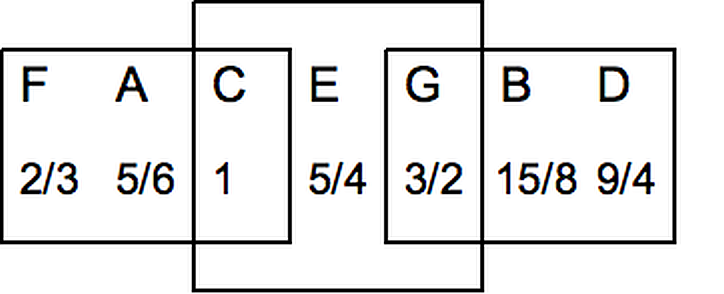John Carlos Baez on Nostr: "Just intonation" is a tuning system where the tones have simple fractions as their ...
"Just intonation" is a tuning system where the tones have simple fractions as their frequency ratios. In the key of C it looks like this. The notes C E G have frequency ratios of 1, 1.25 and 1.5. This is called a "major triad". The notes G B D form another major triad with the same frequency ratios, and so do the notes F A C. This determines the whole tuning system!
Notice here we are working up from C to D, and down from C to F. We're doing that because it's easiest to describe the math that way.
Just intonation may go back to Mesopotamia, but it was carefully described by Claudius Ptolemy - the guy famous for his work on astronomy - in his "Harmonikon" around 140 AD. In fact the term "just intonation" is a bit vague and a more precise term is "Ptolemy's intense diatonic scale":
https://en.wikipedia.org/wiki/Ptolemy%27s_intense_diatonic_scaleI don't know why it's called "intense". Anyway, this scale was advocated by some very influential music theorists in the Renaissance, like Zarlino and Tartini, but it later fell out of fashion for a couple of good reasons.
The fractions in this scale only involve powers of 2, 3 and 5, so it's also called "five-limit tuning":
https://en.wikipedia.org/wiki/Five-limit_tuningIn this scale, multiplying the frequency by 2 takes you up an octave. Multiplying by 3 takes you up an octave and a fifth. And multiplying by 5 takes you up two octaves and a major third.
So: multiplying by 3/2 takes you up an fifth, and multiplying by 5/4 takes you up a third!
A major triad consists of a tone, the tone a third up, and the tone a fifth up. This is why the major triads in this chart get the frequency ratios 1, 5/4 and 3/2, or in other words: 1, 1.25 and 1.5.
(1/n)

Published at
2023-10-03 08:55:58Event JSON
{
"id": "060bded35169ca1d115c772480d8f91afa9ed8e242c614c106d29d14f028daba",
"pubkey": "f7346eb283902ada9d21c109a93e83128d9f87d8fcfe70ad819b3bf2ad9bce16",
"created_at": 1696323358,
"kind": 1,
"tags": [
[
"proxy",
"https://mathstodon.xyz/users/johncarlosbaez/statuses/111170247654517571",
"activitypub"
]
],
"content": "\"Just intonation\" is a tuning system where the tones have simple fractions as their frequency ratios. In the key of C it looks like this. The notes C E G have frequency ratios of 1, 1.25 and 1.5. This is called a \"major triad\". The notes G B D form another major triad with the same frequency ratios, and so do the notes F A C. This determines the whole tuning system!\n\nNotice here we are working up from C to D, and down from C to F. We're doing that because it's easiest to describe the math that way. \n\nJust intonation may go back to Mesopotamia, but it was carefully described by Claudius Ptolemy - the guy famous for his work on astronomy - in his \"Harmonikon\" around 140 AD. In fact the term \"just intonation\" is a bit vague and a more precise term is \"Ptolemy's intense diatonic scale\":\n\nhttps://en.wikipedia.org/wiki/Ptolemy%27s_intense_diatonic_scale\n\nI don't know why it's called \"intense\". Anyway, this scale was advocated by some very influential music theorists in the Renaissance, like Zarlino and Tartini, but it later fell out of fashion for a couple of good reasons.\n\nThe fractions in this scale only involve powers of 2, 3 and 5, so it's also called \"five-limit tuning\":\n\nhttps://en.wikipedia.org/wiki/Five-limit_tuning\n\nIn this scale, multiplying the frequency by 2 takes you up an octave. Multiplying by 3 takes you up an octave and a fifth. And multiplying by 5 takes you up two octaves and a major third.\n\nSo: multiplying by 3/2 takes you up an fifth, and multiplying by 5/4 takes you up a third! \n\nA major triad consists of a tone, the tone a third up, and the tone a fifth up. This is why the major triads in this chart get the frequency ratios 1, 5/4 and 3/2, or in other words: 1, 1.25 and 1.5.\n\n(1/n)\n\nhttps://media.mathstodon.xyz/media_attachments/files/111/170/054/156/928/425/original/9e57303cdb6ffdcb.png",
"sig": "3a3cfe66b3088a972b97b6d2c7fdf24a04c5a72ccebc202fe9be91bbb1b134bcbd420845f54d934fbcb10481eeff1f19a86187837b74b9d6493cf333b899d209"
}
